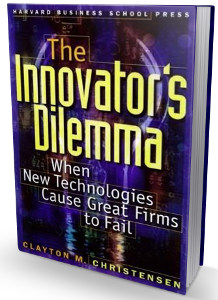Related Research Articles

In chaos theory, the butterfly effect is the sensitive dependence on initial conditions in which a small change in one state of a deterministic nonlinear system can result in large differences in a later state.

In philosophy, systems theory, science, and art, emergence occurs when a complex entity has properties or behaviors that its parts do not have on their own, and emerge only when they interact in a wider whole.

In business theory, disruptive innovation is innovation that creates a new market and value network or enters at the bottom of an existing market and eventually displaces established market-leading firms, products, and alliances. The term, "disruptive innovation" was popularized by the American academic Clayton Christensen and his collaborators beginning in 1995, but the concept had been previously described in Richard N. Foster's book "Innovation: The Attacker's Advantage" and in the paper Strategic Responses to Technological Threats.

Innovation is the practical implementation of ideas that result in the introduction of new goods or services or improvement in offering goods or services. ISO TC 279 in the standard ISO 56000:2020 defines innovation as "a new or changed entity realizing or redistributing value". Others have different definitions; a common element in the definitions is a focus on newness, improvement, and spread of ideas or technologies.
In business and engineering, product development or new product development covers the complete process of bringing a new product to market, renewing an existing product and introducing a product in a new market. A central aspect of NPD is product design, along with various business considerations. New product development is described broadly as the transformation of a market opportunity into a product available for sale. The products developed by an organisation provide the means for it to generate income. For many technology-intensive firms their approach is based on exploiting technological innovation in a rapidly changing market.

Clayton Magleby Christensen was an American academic and business consultant who developed the theory of "disruptive innovation", which has been called the most influential business idea of the early 21st century. Christensen introduced "disruption" in his 1997 book The Innovator's Dilemma, and it led The Economist to term him "the most influential management thinker of his time." He served as the Kim B. Clark Professor of Business Administration at the Harvard Business School (HBS), and was also a leader and writer in the Church of Jesus Christ of Latter-day Saints. He was one of the founders of the Jobs to Be Done development methodology.
An organizational structure defines how activities such as task allocation, coordination, and supervision are directed toward the achievement of organizational aims.
A value network is a graphical illustration of social and technical resources within/between organizations and how they are utilized. The nodes in a value network represent people or, more abstractly, roles. The nodes are connected by interactions that represent deliverables. These deliverables can be objects, knowledge or money. Value networks record interdependence. They account for the worth of products and services. Companies have both internal and external value networks.
Organizational intelligence (OI) is the capability of an organization to comprehend and create knowledge relevant to its purpose; in other words, it is the intellectual capacity of the entire organization. With relevant organizational intelligence comes great potential value for companies and organizations to figure out where their strengths and weaknesses lie in responding to change and complexity.
Equifinality is the principle that in open systems a given end state can be reached by many potential means. The term and concept is due to Hans Driesch, the developmental biologist, later applied by Ludwig von Bertalanffy, the founder of general systems theory, and by William T. Powers, the founder of perceptual control theory. Driesch and von Bertalanffy prefer this term, in contrast to "goal", in describing complex systems' similar or convergent behavior. Powers simply emphasised the flexibility of response, since it emphasizes that the same end state may be achieved via many different paths or trajectories.

The technology adoption lifecycle is a sociological model that describes the adoption or acceptance of a new product or innovation, according to the demographic and psychological characteristics of defined adopter groups. The process of adoption over time is typically illustrated as a classical normal distribution or "bell curve". The model indicates that the first group of people to use a new product is called "innovators", followed by "early adopters". Next come the early majority and late majority, and the last group to eventually adopt a product are called "Laggards" or "phobics." For example, a phobic may only use a cloud service when it is the only remaining method of performing a required task, but the phobic may not have an in-depth technical knowledge of how to use the service.

Arie Rip is a Dutch professor emeritus of Philosophy of Science and Technology.
Dominant design is a technology management concept introduced by James M. Utterback and William J. Abernathy in 1975, identifying key technological features that become a de facto standard. A dominant design is the one that wins the allegiance of the marketplace, the one to which competitors and innovators must adhere if they hope to command significant market following.
Discovery-driven planning is a planning technique first introduced in a Harvard Business Review article by Rita Gunther McGrath and Ian C. MacMillan in 1995 and subsequently referenced in a number of books and articles. Its main thesis is that when one is operating in arenas with significant amounts of uncertainty, that a different approach applies than is normally used in conventional planning. In conventional planning, the correctness of a plan is generally judged by how close outcomes come to projections. In discovery-driven planning, it is assumed that plan parameters may change as new information is revealed. With conventional planning, it is considered appropriate to fund the entire project, as the expectation is that one can predict a positive outcome. In discovery-driven planning, funds are released based on the accomplishment of key milestones or checkpoints, at which point additional funding can be made available predicated on reasonable expectations for future success. Conventional project management tools, such as stage-gate models or the use of financial tools to assess innovation, have been found to be flawed in that they are not well suited for the uncertainty of innovation-oriented projects
Organizational ambidexterity refers to an organization's ability to be efficient in its management of today's business and also adaptable for coping with tomorrow's changing demand. Just as being ambidextrous means being able to use both the left and right hand equally, organizational ambidexterity requires the organizations to use both exploration and exploitation techniques to be successful.
Organizational Information Theory (OIT) is a communication theory, developed by Karl Weick, offering systemic insight into the processing and exchange of information within organizations and among its members. Unlike the past structure-centered theory, OIT focuses on the process of organizing in dynamic, information-rich environments. Given that, it contends that the main activity of organizations is the process of making sense of equivocal information. Organizational members are instrumental to reduce equivocality and achieve sensemaking through some strategies — enactment, selection, and retention of information. With a framework that is interdisciplinary in nature, organizational information theory's desire to eliminate both ambiguity and complexity from workplace messaging builds upon earlier findings from general systems theory and phenomenology.
The Norwegian paradox is a dilemma of Norway's economic performance where economic performance is strong despite low R&D investment.
Innosight is a strategy consultancy within Huron Consulting Group, advising enterprises on business strategy. Innosight was founded in 2000 by Harvard Business School professor Clayton M. Christensen and senior partner Mark W. Johnson. Innosight uses methods based on the concept of disruptive innovation, a theory defined by Christensen in his book The Innovator's Dilemma. The company headquarters is located in Lexington, MA, with additional offices in Singapore and Switzerland. Scott D. Anthony is the firm's managing partner.

The Innovator's Dilemma: When New Technologies Cause Great Firms to Fail, first published in 1997, is the best-known work of the Harvard professor and businessman Clayton Christensen. It expands on the concept of disruptive technologies, a term he coined in a 1995 article "Disruptive Technologies: Catching the Wave". It describes how large incumbent companies lose market share by listening to their customers and providing what appears to be the highest-value products, but new companies that serve low-value customers with poorly developed technology can improve that technology incrementally until it is good enough to quickly take market share from established business. Christensen recommends that large companies maintain small, nimble divisions that attempt to replicate this phenomenon internally to avoid being blindsided and overtaken by startup competitors.
Innovation leadership is a philosophy and technique that combines different leadership styles to influence employees to produce creative ideas, products, and services. The key role in the practice of innovation leadership is the innovation leader. Dr. David Gliddon (2006) developed the competency model of innovation leaders and established the concept of innovation leadership at Penn State University.
References
- ↑ Anderson, E.G. Jr. and Joglekar, N.R. (2007). "Chasing the Innovation Butterfly with 'Systems Thinking'", The Systems Thinker, 18(9): 7–9.
- ↑ Sterman, J.D. (1994). "Learning in and about Complex Systems", System Dynamics Review, 10(2–3): 291–330.
- 1 2 Anderson and Joglekar (2007), pp. 7–9.
- ↑ Anderson, Edward G and Nitin R. Joglekar. (2012). The Innovation Butterfly: Managing Emergent Opportunities and Risks During Distributed Innovation. Springer (Understanding Complex Systems Series)"
- ↑ Anderson, Edward G. and Nitin Joglekar (2005). A Hierarchical Modeling Framework for Product Development Planning. Production and Operations Management, 14 (3): 344–361.
- ↑ Garud, R. and Karnøe, P. 2001 Path Creation as a Process of Mindful Deviation. In Path Dependence and Creation, R. Garud and P. Karnøe (eds.) Lawrence Erlbaum Associates: 1–38.
- ↑ Christensen, Clayton M. (1997). The Innovator's Dilemma : When New Technologies Cause Great Firms to Fail. Harvard Business Press.